THERMOREGULATORY COSTS… This specialized calculator, of interest mainly to thermal physiologists, uses weather (temperature) data from a loaded file to estimate the energy cost of thermoregulation for an endotherm: e.g., bird or mammal. The calculations produce a mean cost of thermoregulation, plus several related values, over whatever period the weather data encompass.
| Important caution: for temperature data, the program's default 'assumption' is that a value of zero = bad data (or no data). If your temperatures include real values of zero, then use .001 (or some other small but non-zero number) instead of zero.
|
Thermoregulatory costs are calculated using the following thermal parameters: body temperature (Tb), lower critical temperature (LCT), thermal conductance (Cth; watts/°C), and basal metabolic rate (BMR; ml O2/min or watts; selected in the 'options' window) in a set of edit fields. The program also asks for a channel containing time of day in hours (0-24) and two channels containing environmental temperatures (Te), one for shade and one for sun. Note: If shade temperature is missing, the program will substitute sun temperature (if available), but only at night. If sun temperature is missing, the program will substitute shade temperature (if available).
For each point in the data file, the necessary metabolic rate is computed according to the following rules:
if the animal is day-active, whichever Te (sun or shade) is highest is used in calculations. Note that if a day-active species never has access to sunlight (e.g., stays in deep shade), you can select the shade temperature as the sun temperature.
at Te >= LCT, metabolic rate is set equal to BMR (internally converted to watts)
at Te < LCT, metabolic rate is computed as (Tb - Te) * Cth
When Te < LCT in the inactive part of the daily cycle, if the animal can use torpor (selected in the 'options' window), one of two calculations are performed:
-- if Te is at or above 1 °C less than a minimal (defended) Tb, the metabolic rate is reduced from BMR in proportion to how close Te is to minimum Tb.
-- if Te is lower than 1°C below the minimum Tb, metabolic rate is computed as (minimum Tb - Te) * Cth
--
Flowcharts (decision trees) for calculations of environmental temperature and thermoregulatory costs are at the end of this section.
Program output includes:
mean metabolic rate (watts)
factorial increase of mean metabolic rate above BMR
highest single metabolic rate (watts)
factorial increase of highest metabolic rate above BMR
percent of total samples for which metabolic rate = BMR (i.e., Te > LCT)
mean metabolic rate for all samples where Te < LCT
factorial increase above BMR for mean metabolic rate for all samples where Te < LCT
maximum daily average (watts), and expressed as factorial increase above BMR
maxima over 6 and 12 hours (watts), and expressed as factorial increase above BMR
mean metabolic rate while in torpor (watts), and expressed as factorial change from BMR
percent of time spent in torpor
| NOTE: For nightime data, if a value for shade temperature is missing, the program will attempt to use the sun temperature value instead. This substitution does not occur for daytime data.
|
These thermal calculations are performed in one of two ways:
One individual at a time (click the 'compute costs' button): The user enters the animal's thermal parameters in edit fields in the main program window, selects the time, sun, and shade temperature channels, and then starts calculations. Results are shown after all Te data are processed:
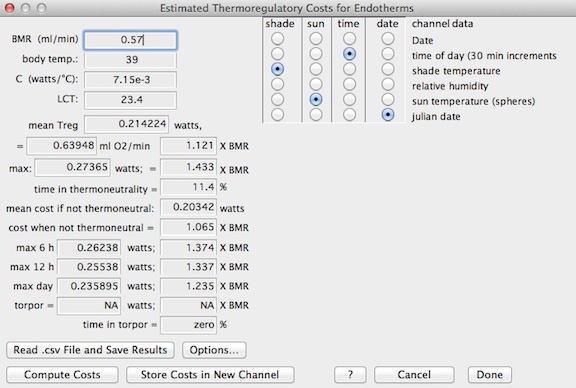
Optionally, the computed costs for each entry in the main data file can be saved in a new channel (if the file has < 32 channels).
Multiple individuals (species) in a spreadsheet
(click the 'read .csv file and save results' button): The user selects the time and two Te channels (sun and shade) and then opens a spreadsheet file (comma separated variables; .csv) containing a series of thermal parameters for different species, sexes, etc. The maximum number of variables in the .csv spreadsheet is 50. Each row of the spreadsheet (up to 800) contains data for one individual or species. You need to select the columns that contain:
an indicator (yes, no, y, n, 1, 0) of whether the animal can 'use' sunlight to warm itself. If true, the calculations use the 'sunshine' value in the main data file of temperature data.
body temperature, in degrees C
minimum thermal conductance, in watts/degree C (here, degrees C is the gradient between body temperature and environmental temperature).
the Lower Critical Temperature (LCT) in degrees C.
Basal Metabolic Rate (BMR); the units are either watts or ml O2/min (selected in the 'options' window).
an indicator (yes, no, y, n, 1, 0) of whether the animal can use torpor to save energy during the inactive phase (night or day) of its daily cycle.
the minimum body temperature (Tb; degrees C) that the animal will tolerate in torpor. The lowest environmental temperature at which this is achieved without increasing metabolism is assumed to be 1 °C lower than minimum Tb. At lower Te, the animal will increase metabolic heat production to maintain Tb at the minimum value. The program uses the thermal conductance value (Cth) to calculate this metabolic rate.
an indicator (yes, no, y, n, 1, 0, D, d, N, n) of whether the animal's active phase is during the day (diurnal) or at night (nocturnal). A 'yes' or '1' value or equivalent means the animal is diurnal.
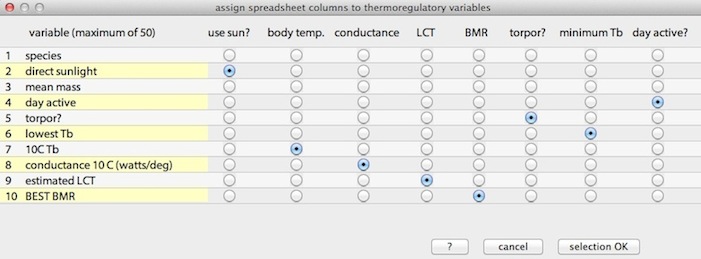
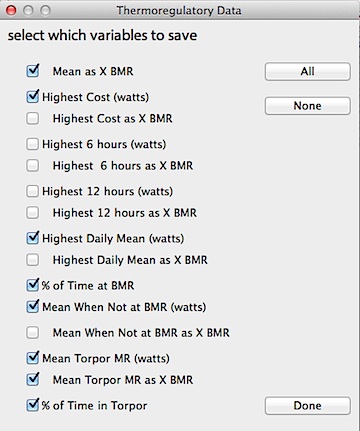 For each spreadsheet entry, the program runs through the Te channels from the main data file. The combined results can be saved, along with the raw data from the 'source' .csv file, in a user-selected spreadsheet file.
For each spreadsheet entry, the program runs through the Te channels from the main data file. The combined results can be saved, along with the raw data from the 'source' .csv file, in a user-selected spreadsheet file.
The program always saves a column containing the mean thermoregulatory cost in watts.
Other thermoregulatory data columns to be placed in the spreadsheet are selected from the window at right:
For both methods, the 'options' button opens a window where you can select a number of alternate ways of handling data and calculations, including:
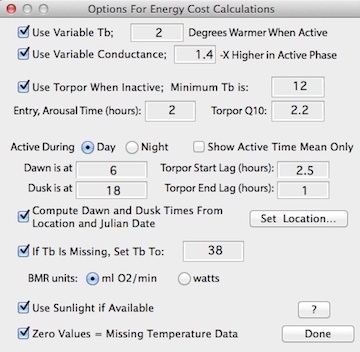
This flowchart shows how environmental temperature (Te) is selected:
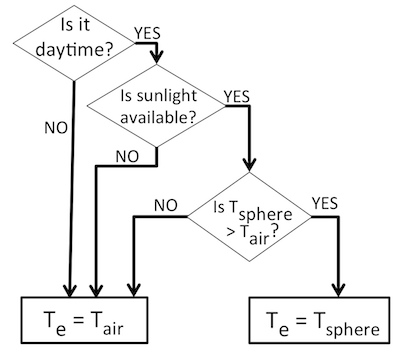
This flowchart shows how Te, time, and physiological parameters are used to compute thermoregulatory energy costs:
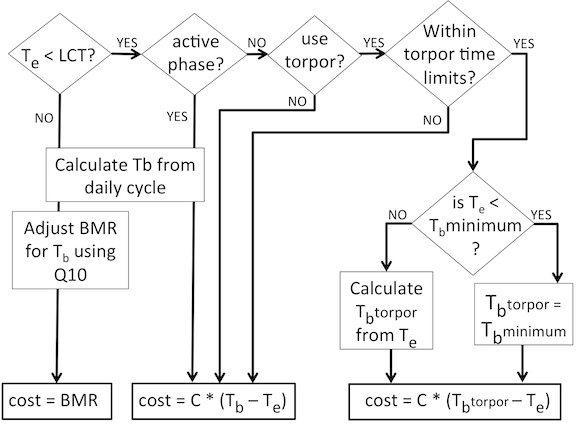
Back to top
DAY OF THE YEAR... 'j' This simple calculator will provide the Julian date (days since December 31) for a combination of date, month, and year. It should account for leap years.
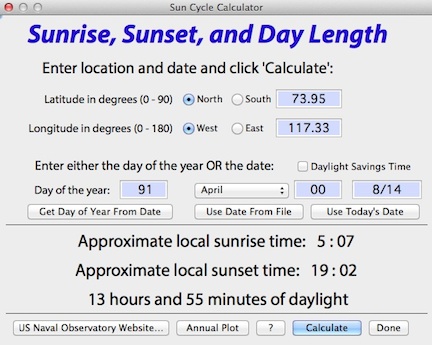 SUN CYCLE CALCULATOR... This utility uses the well-known ‘Sunrise equation’ to compute the approximate times of sunrise and sunset from date (month, day, year) and location (degrees latitude and longitude). You need to select North or South latitude, and East or West longitude relative to the Prime Meridian.
SUN CYCLE CALCULATOR... This utility uses the well-known ‘Sunrise equation’ to compute the approximate times of sunrise and sunset from date (month, day, year) and location (degrees latitude and longitude). You need to select North or South latitude, and East or West longitude relative to the Prime Meridian.
NOTE: The program expects latitude and longitude in fractional degrees, not degrees and minutes. Thus 27° 30’ north should be entered as ’27.5’ (i.e., halfway between 27° N and 28° N).
Sun time estimates are approximate for several reasons:
• Sunrise and sunset times are based on local solar noon (i.e., when the sun is at its zenith (highest above the horizon) from the perspective of the observer’s position. This is likely to be slightly different from local time. As defined by people, time zones are arbitrary, and since they are roughly 15 ° of longitude wide and often do not run strictly north and south, sunrise and sunset times can vary by an hour or more with a single time zone.
• The calculator has no allowance for elevation above sea level (which makes rise times earlier and set times later, if the horizon is at sea level). It also has no allowance for local topography — for example, if the observer is in a deep valley, the visual horizon is elevated above the ‘real’ horizon, and rise times will be later and set times will be earlier than shown here.
• The precise times of sunrise and sunset are of concern to astronomers and the like, but for most purposes they are rather ‘fuzzy’ due to the angular diameter of the solar disc (about 32 minutes of arc or 0.53 degrees), atmospheric refraction, etc.
NOTE: The U.S. Naval Observatory hosts a web page (USNO Sun and Moon Data) that permits very accurate calculations of solar and lunar data. It incorporates ‘fixes’ for many of the issues described above, and — if you are connected to the internet — can be accessed with the ‘Naval Observatory Website’ button.
• The 'Annual Plot' button will compute and display an entire year's day length cycle, based on latitude-longitude position. The 'Print Data to Spreadsheet' button makes a tab-delineated .xls spreadsheet containing the annual cycle (date, sunrise time, sunset time, and day length). This example shows a Polar-region cycle, with complete darkness in winter and 24-hour sunlight in summer:
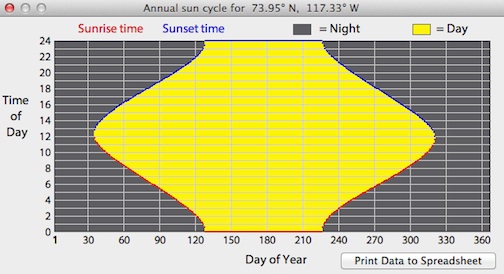
UNIT CONVERSIONS... 'u' This provides a number of unit conversion options for distance, mass, area, pressure, temperature, rate time units, energy, water loss, light intensity. It is similar to (but more comprehensive than) many of the options in the 'transformations' routines in the EDIT menu. You need to select a general type of conversion from four choices, then pick the specific conversion from the pop-up menu. For some conversion, text describing special conditions will appear.
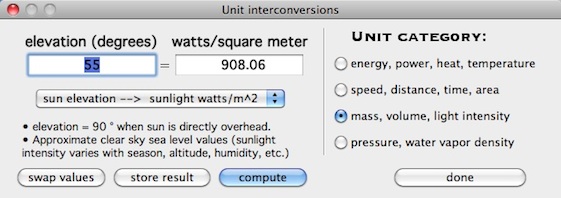
|

